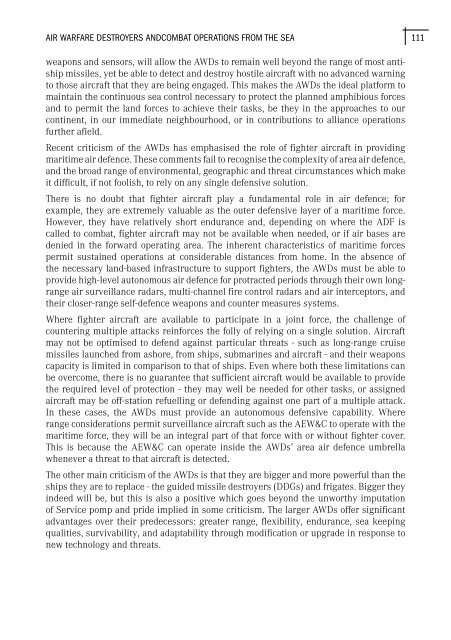Australian Maritime Issues 2005 - Royal Australian Navy
Australian Maritime Issues 2005 - Royal Australian Navy
Australian Maritime Issues 2005 - Royal Australian Navy
Create successful ePaper yourself
Turn your PDF publications into a flip-book with our unique Google optimized e-Paper software.
AIR WARFARE DESTROYERS ANDCOMBAT OPERATIONS FROM THE SEA<br />
111<br />
weapons and sensors, will allow the AWDs to remain well beyond the range of most antiship<br />
missiles, yet be able to detect and destroy hostile aircraft with no advanced warning<br />
to those aircraft that they are being engaged. This makes the AWDs the ideal platform to<br />
maintain the continuous sea control necessary to protect the planned amphibious forces<br />
and to permit the land forces to achieve their tasks, be they in the approaches to our<br />
continent, in our immediate neighbourhood, or in contributions to alliance operations<br />
further afield.<br />
Recent criticism of the AWDs has emphasised the role of fighter aircraft in providing<br />
maritime air defence. These comments fail to recognise the complexity of area air defence,<br />
and the broad range of environmental, geographic and threat circumstances which make<br />
it difficult, if not foolish, to rely on any single defensive solution.<br />
There is no doubt that fighter aircraft play a fundamental role in air defence; for<br />
example, they are extremely valuable as the outer defensive layer of a maritime force.<br />
However, they have relatively short endurance and, depending on where the ADF is<br />
called to combat, fighter aircraft may not be available when needed, or if air bases are<br />
denied in the forward operating area. The inherent characteristics of maritime forces<br />
permit sustained operations at considerable distances from home. In the absence of<br />
the necessary land-based infrastructure to support fighters, the AWDs must be able to<br />
provide high-level autonomous air defence for protracted periods through their own longrange<br />
air surveillance radars, multi-channel fire control radars and air interceptors, and<br />
their closer-range self-defence weapons and counter measures systems.<br />
Where fighter aircraft are available to participate in a joint force, the challenge of<br />
countering multiple attacks reinforces the folly of relying on a single solution. Aircraft<br />
may not be optimised to defend against particular threats - such as long-range cruise<br />
missiles launched from ashore, from ships, submarines and aircraft - and their weapons<br />
capacity is limited in comparison to that of ships. Even where both these limitations can<br />
be overcome, there is no guarantee that sufficient aircraft would be available to provide<br />
the required level of protection - they may well be needed for other tasks, or assigned<br />
aircraft may be off-station refuelling or defending against one part of a multiple attack.<br />
In these cases, the AWDs must provide an autonomous defensive capability. Where<br />
range considerations permit surveillance aircraft such as the AEW&C to operate with the<br />
maritime force, they will be an integral part of that force with or without fighter cover.<br />
This is because the AEW&C can operate inside the AWDs’ area air defence umbrella<br />
whenever a threat to that aircraft is detected.<br />
The other main criticism of the AWDs is that they are bigger and more powerful than the<br />
ships they are to replace - the guided missile destroyers (DDGs) and frigates. Bigger they<br />
indeed will be, but this is also a positive which goes beyond the unworthy imputation<br />
of Service pomp and pride implied in some criticism. The larger AWDs offer significant<br />
advantages over their predecessors: greater range, flexibility, endurance, sea keeping<br />
qualities, survivability, and adaptability through modification or upgrade in response to<br />
new technology and threats.

















